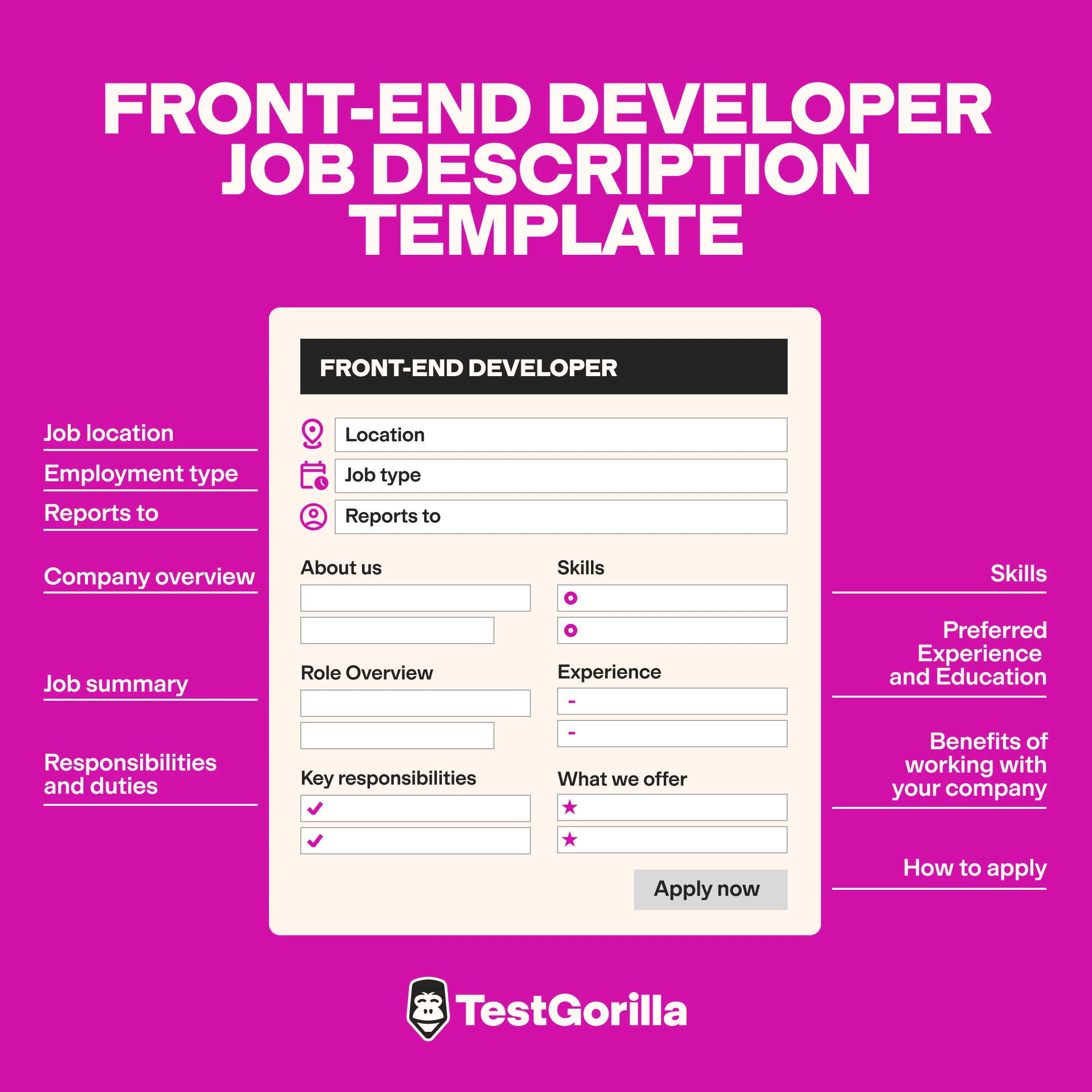Front-end developer job description template: Everything you need to include
With rapidly changing web tech and fierce competition for talent, hiring a front-end developer is tough.
A good job description can help by attracting skilled candidates who can weather tech changes, create phenomenal user experiences, and more. Meanwhile, a subpar job description could draw in all the wrong applicants – while turning away devs with the skills you need.
Below, we included a front-end developer job description you can customize. Plus, we discuss how to use skills-based hiring to find the most skilled developer.
Front-end developer job description template
Job Title: Front-End Developer
Location: [Insert Location]
Reports To: Lead Developer or Engineering Manager
Job Type: [Full-time/Part-time/Contract]
About Us
[Company Name] is an innovative company specializing in [brief description of the company’s focus, such as web applications, e-commerce, digital solutions]. Our mission is to [state the mission, e.g., “create seamless digital experiences that engage and inspire users”]. We value [core values, such as creativity, collaboration, and customer focus] and are committed to building a team that thrives on achieving impactful results. Known for our [unique strengths, e.g., user-centered design or cutting-edge technology], we strive to stay at the forefront of the [industry/sector].
Job Overview
We are seeking a talented Front-End Developer to join our development team. This role involves translating UI/UX designs into functional code, optimizing web applications for maximum speed and scalability, and ensuring our products deliver an exceptional user experience. The ideal candidate is skilled in front-end web technologies, has a keen eye for design, and is passionate about delivering high-quality digital products.
Key Responsibilities
Develop new features for users, ensuring consistency and responsiveness across devices.
Translate UI/UX wireframes and designs into high-quality, efficient code using HTML, CSS, and JavaScript.
Collaborate with designers, back-end developers, and other team members to integrate front-end and back-end elements smoothly.
Optimize applications for maximum speed, performance, and scalability.
Implement best practices for web accessibility, cross-browser compatibility, and user experience.
Work with modern front-end frameworks such as React, Angular, or Vue.js to build dynamic applications.
Write clean, reusable, and maintainable code while adhering to industry standards and best practices.
Debug and troubleshoot issues with front-end code, improving user experience and resolving bugs.
Take part in code reviews and give constructive and helpful feedback to team members.
Stay updated with emerging front-end technologies, best practices, and trends.
Contribute to Agile or Scrum processes, including sprint planning and retrospectives.
Skills
Strong knowledge of front-end languages and frameworks, including HTML5, CSS3, and JavaScript (ES6+).
Proficiency with modern JavaScript frameworks such as React, Angular, or Vue.js.
Experience with CSS pre-processors like SASS or LESS and CSS frameworks like Bootstrap or Tailwind.
Familiarity with front-end build tools (e.g., Webpack, Babel) and version control systems (e.g., Git).
Understanding of RESTful APIs and experience in integrating with back-end services.
Knowledge of UI/UX design principles, with the ability to implement designs accurately and intuitively.
Ability to troubleshoot cross-browser and cross-platform compatibility issues.
Strong problem-solving skills and an analytical mindset with attention to detail.
Excellent communication skills for effective collaboration with team members and stakeholders.
A knack for innovative solutions and a fresh approach to visual and interactive design.
Experience with testing frameworks (e.g., Jest, Mocha) is a plus.
Preferred Experience and Education
Proven experience as a Front-End Developer or similar role, with a portfolio of previous web applications.
Bachelor’s degree in Computer Science, Web Development, or a related field.
Familiarity with Agile development methodologies and experience working in a collaborative environment.
Basic knowledge of back-end development (e.g., Node.js, Express) is beneficial.
Industry certifications in front-end development or JavaScript frameworks are a plus.
Benefits
[List benefits of joining your company, such as health coverage, paid time off, remote work options, opportunities for professional development, a creative and collaborative work environment, etc.]
Application Instructions
If you’re passionate about front-end development and ready to create amazing user experiences, we’d love to hear from you. Please send your [list application materials you want to see from applicants – for instance, a link to their portfolios or GitHubs] to [email address] by [application deadline].
Why this front-end developer job description template works
We’ve built our job description to lure in qualified candidates while setting crystal clear expectations.
First, we show candidates who they’ll report to. This helps them understand where they’d fit within your engineering team's hierarchy and how they’d communicate with others.
The About Us section highlights what the company specializes in, its mission and core values, and its strengths. Follow this approach, and you’ll attract devs who can handle your specializations (like web applications), vibe with your values (like creativity), and appreciate your company’s unique attributes (like its use of innovative tech).
In the Job Overview, we talk up the importance of having strong tech expertise and creating a good user experience (UX). This shows that the job isn’t just about coding – it’s also about design: making things look good and work well.
Our Key Responsibilities section starts with tech tasks but still includes other tasks – like working with the team. Candidates who can’t see themselves splitting their time between coding on their own and collaborating with others are less likely to apply.
We divide the Skills section into technical and soft skills because modern front-end developers need both. We list essential tech skills like HTML, CSS, and JavaScript and mention other tools and frameworks. We don’t include specific versions – tech changes fast and we don’t want the job description to become outdated or push away skilled candidates who aren’t familiar with one specific version.
Prachi Singh, a Digital Marketing Executive, highlights the importance of both technical and soft skills for the role. She says:
The front-end development of UI/UX (Interaction Design) is about implementation. A website cannot be built without creativity and problem-solving skills (while navigating the complexities of adding UI elements).
This is why we’ve included soft skills like “a knack for innovation” to our list of skills.
Next, the Preferred Experience and Education section balances formal qualifications with practical experience. We use the word “preferred” to recognize that in front-end development, hands-on skills matter more than degrees.
The Benefits section speaks directly to front-end developers' needs, like having the right tools and opportunities to hone their craft.
The best insights on HR and recruitment, delivered to your inbox.
Biweekly updates. No spam. Unsubscribe any time.
Next steps: Attracting and assessing front-end developers candidates
Now that your front-end developer job description is all set, post your job in places where developers are likely to see it – including general and industry-specific job boards.
Next, you must assess your applicants. At TestGorilla, we believe talent assessments offer the most effective way to evaluate candidates compared with traditional screening methods. We recommend using these assessments as a tool to screen all your applicants.
With our platform, you can mix up to five tests to create a front-end developer assessment. Our test library offers several skill tests specifically designed for assessing front-end developers. These include:
HTML5 test
CSS test
JavaScript test
Clean Code test
React test
Coding: Debugging test
The Coding: Debugging test offers options in 20 languages, including Java, PHP, C#, Ruby, and Python. You can pick the language – or let candidates choose the language they’re most comfortable with.
You can also use other tests, such as:
Problem Solving test
Critical Thinking test
Communication test
Culture Add test
Our system automatically scores candidates for you, so picking the most skilled candidates to interview is a breeze. Once you’re at the interview stage, check out our front-end interview questions.
Get started with TestGorilla today by signing up for an account!
FAQs
What describes a front-end developer?
A front-end developer designs and implements the visible parts of a website and web applications. They make sure everything users see and interact with – such as layouts, buttons, and animations – is both functional and visually appealing.
Is HTML front end or back end?
HTML (HyperText Markup Language) is a front-end technology. Developers use it to structure and display content on the web, and it forms the backbone of what users see and interact with in their browsers. It works alongside other front-end technologies like CSS and JavaScript.
What is the average salary for a front-end developer?
Front-end developer salaries vary by location, experience, and skill set. According to Indeed, as of 2024, the average salary is approx. $112,000 in the US.
What's the difference between a front-end developer and a full-stack developer?
Front-end developers specialize in client-side development (what users see and interact with), while full-stack developers work on both client-side and server-side development.
Related posts
You've scrolled this far
Why not try TestGorilla for free, and see what happens when you put skills first.
















